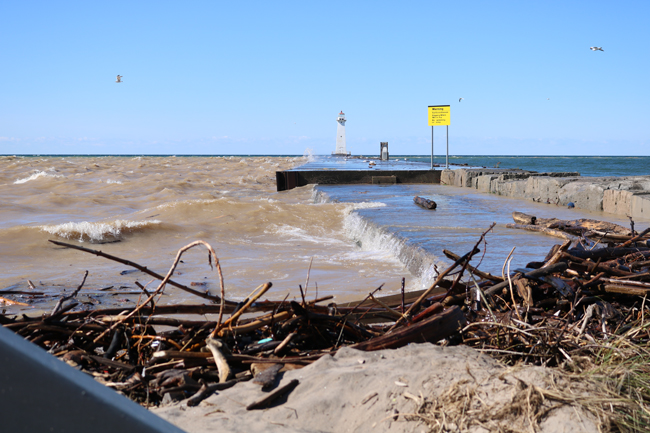
Lighthouse and pier at Sodus Point NY. Credit: Mary Austerman/NYSG.
— Filed by Jan Wesner Childs for Weather.com
At a Glance
An extremely wet winter and spring have led to record-high water levels in the Great Lakes.
Flooding has occurred in Michigan, New York, Ohio and Pennsylvania.
Scientists say the the situation is only likely to get worse.
Buffalo, NY, June 3, 2019 - Waves crashing over sea walls.
Water flooding homes and businesses.
Docks and marinas underwater.
Fish swimming on what used to be dry land.
This is the scene around the Great Lakes, particularly Lake Ontario and Lake Erie, as every one of the Great Lakes are at their highest levels ever recorded for the month of May.
The problem has been ongoing throughout the spring, but reached critical levels in May. The U.S. Army Corps of Engineers in Detroit said Lake Ontario rose an additional 18 inches last month alone, putting it 24 inches higher than it was at the same time last year. Lake Michigan-Huron rose 9 inches, Erie rose 6 inches and Superior rose 5 inches. Those lakes were all 9 to 13 inches higher than a year ago, and each of the Great Lakes was between 1 to 6 inches higher than ever recorded for the month of May.
While the higher waters improve shipping channels and allow bigger boats to go through, they wreak havoc on businesses and property owners along the shoreline. Parts of Toronto and Detroit have flooded, as well as other communities in Michigan, Ohio, New York and Pennsylvania.
“As far as people are concerned, it’s an economic impact," Helen Domske, senior coastal education specialist with New York Sea Grant program with the University at Buffalo, told weather.com.
The situation becomes even more dire when heavy winds push waters up onto the shoreline and into streets, businesses and homes.
“That causes erosion, that causes the soil to slough away, so people can actually lose their property, inches and inches of their property, and over time that adds up,” Domske said.
The lower Great Lakes are impacted even more because of water levels flowing down from the upper lakes, she added.
Heavy snowfall and spring rains contributed to the problem. Domske said New York received 60 inches of snow in January, which is half the normal total for whole year.
“And when that snow fell it had to melt and when it melts it goes into the Great Lakes,” she said.
Other communities around the lakes experienced a similar increase in precipitation. In May, especially, the Great Lakes basin received 28% more precipitation than usual for the month, according to the Corps of Engineers. Ontario's rainfall was 52% above normal.
A recent study also found the Great Lakes region was warming faster than the rest of the country, leading scientists to predict that flooding will only become worse in coming years.
The last time waters were near this high was 2017. Domske said many people spent tens of thousands of dollars protecting their homes with rock barriers along the shoreline. Now, she said, those rocks are washing away.
As summer swings into high gear, tourism and recreational boating are also affected. At least one New York lakefront community has closed its beach for the season, and boaters are being warned to watch for underwater hazards like docks and seawalls.
“It really does have a big impact on the people who live along the lakes,” Domske said.
More Info: New York Sea Grant
New York Sea Grant (NYSG), a cooperative program of Cornell University
and the State University of New York (SUNY), is one of 33 university-based
programs under the National Oceanic and Atmospheric Administration’s
National Sea Grant College Program.
Since 1971, NYSG has represented a statewide network of integrated
research, education and extension services promoting coastal community
economic vitality, environmental sustainability and citizen awareness
and understanding about the State’s marine and Great Lakes resources.
Through NYSG’s efforts, the combined talents of university scientists
and extension specialists help develop and transfer science-based
information to many coastal user groups—businesses and industries,
federal, state and local government decision-makers and agency managers,
educators, the media and the interested public.
The program maintains Great Lakes offices at Cornell University, SUNY
Buffalo, SUNY Oswego and the Wayne County Cooperative Extension office
in Newark. In the State's marine waters, NYSG has offices at Stony Brook
University in Long Island, Brooklyn College and Cornell Cooperative
Extension in NYC and Kingston in the Hudson Valley.
For updates on Sea Grant activities: www.nyseagrant.org has RSS, Facebook, Twitter, and YouTube links. NYSG offers a free e-list sign up via www.nyseagrant.org/nycoastlines for its flagship publication, NY Coastlines/Currents, which is published quarterly. Our program also produces an occasional e-newsletter,"NOAA Sea Grant's Social Media Review," via its blog, www.nyseagrant.org/blog.